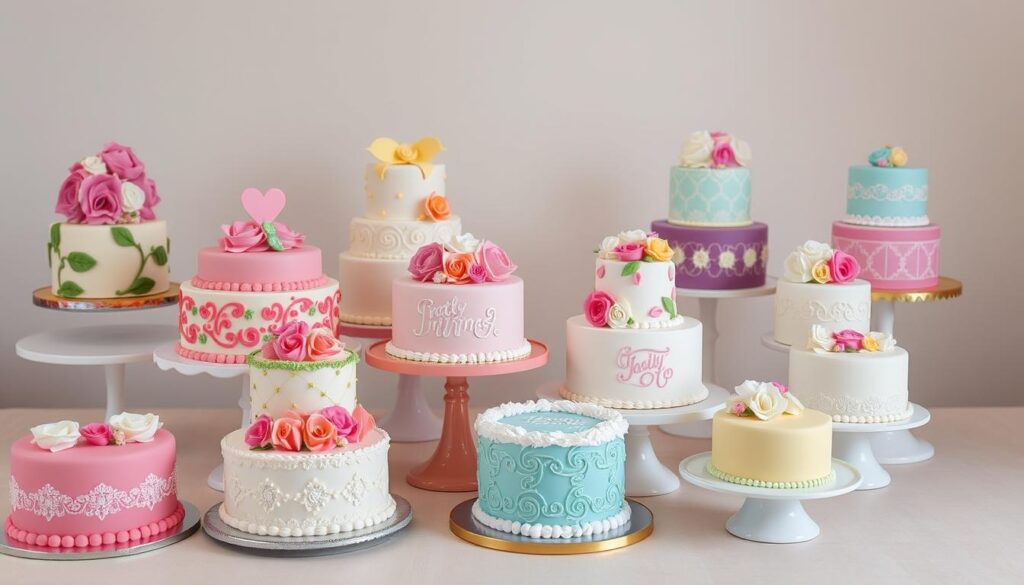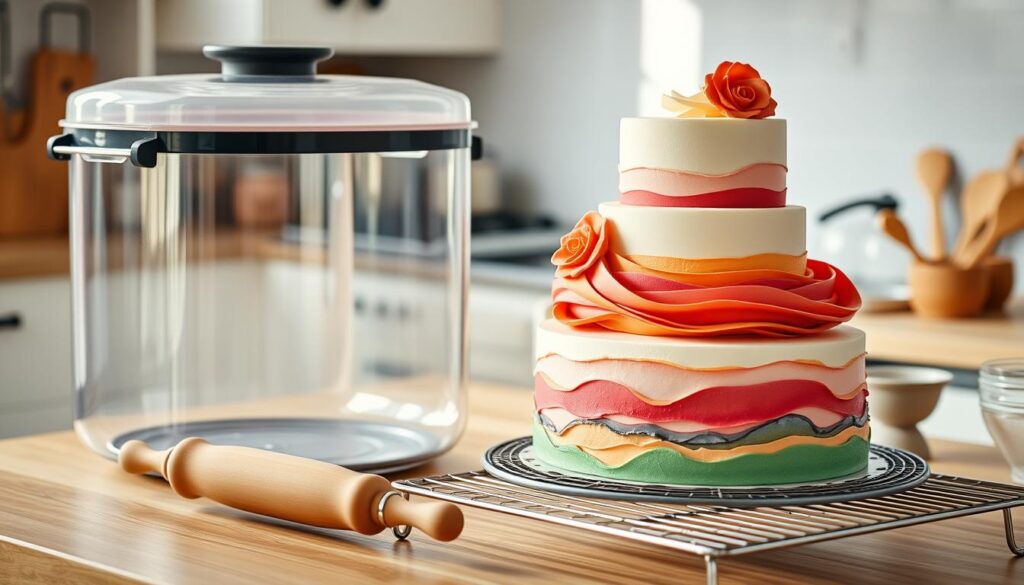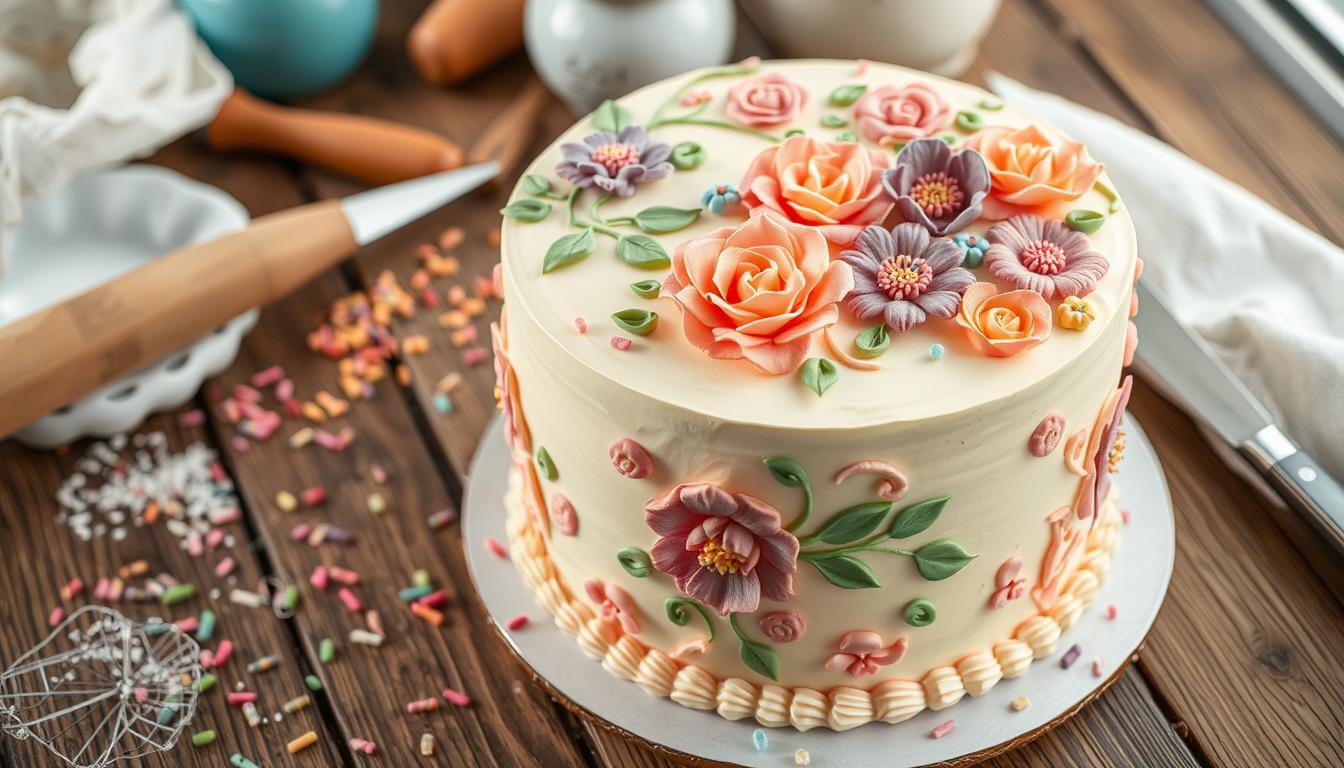There’s something magical about showing off a fondant cake at a special event. It’s more than just dessert; it’s about the memories made. Whether it’s a wedding, birthday, or any big moment, a fondant cake can bring joy and smiles.
Imagine your friends and family’s faces lighting up as they see the cake. Fondant cakes are a big deal, making up 70% of wedding cakes and 50% of fancy birthday cakes. They add elegance and make any theme pop, with endless ideas to choose from.
The need for custom and themed cakes is growing fast, up by 10% each year. Knowing how to work with fondant is key. This guide will help you pick or make a fondant cake that wows everyone.
Key Takeaways
- Fondant cakes are essential for elegant celebrations, prominent in 70% of weddings.
- Understanding different types of fondant helps enhance creativity in cake design.
- Flavor combinations can significantly impact the overall experience of your cake.
- Choosing the right cake fillings ensures harmony with the fondant’s sweetness.
- Effective storage and transportation methods preserve the beauty and taste of fondant cakes.
- Avoiding common fondant mistakes contributes to a successful cake decorating process.
- Keeping up with fondant cake trends adds a modern touch to your creations.
What is Fondant Cake?
A fondant cake is a stunning dessert with a smooth icing called fondant. It’s made of sugar, water, gelatin, and glycerin. This icing lets bakers make detailed designs and shiny finishes perfect for big events like weddings and birthdays.
The fondant cake importance is in how it makes any event look better. It turns a simple cake into a showstopper.
Definition and Importance
Fondant has a long history in cake decorating. It started as a new way to decorate cakes and has become a key part of baking. The fondant cake importance is huge, as it’s used in fancy cakes, like wedding cakes.
Unlike cream cakes, fondant is strong and lets flavors grow. It’s also great for making detailed designs because it’s like modeling clay.
History of Fondant in Baking
The history of fondant begins in Europe, where it was first used as a sugar paste. Over time, it got better with new ingredients for taste and texture. Today, fondant is popular for making cakes that everyone can enjoy, even those with nut allergies.
It’s also easy to find ready-made fondant, which is great for many decorators. These versions might have things like cellulose gum in them.
| Type of Fondant | Ingredients | Common Uses |
|---|---|---|
| Rolled Fondant | Sugar, water, gelatin, food-grade glycerine | Wedding cakes, detailed designs |
| Poured Fondant | Sugar, water, gelatin, glycerine | Glazing desserts, filling |
| Marshmallow Fondant | Marshmallows, powdered sugar, shortening | Home baking, beginner-friendly |
Types of Fondant: An Overview
Exploring the different types of fondant can make cake decorating more fun. Each fondant has its own special qualities and uses. You can pick the one that works best for your baking projects. Let’s look at rolled fondant, pourable fondant, and other options.
Rolled Fondant
Rolled fondant is a favorite among cake decorators. It’s soft and easy to roll out and apply. It’s great for covering cakes and making detailed designs.
This fondant gives cakes a smooth, shiny look. It’s a bit challenging, but worth it for the results. About 80% of decorators choose it for its versatility and beauty.
Pourable Fondant
Pourable fondant is perfect for glazing cakes and pastries. It’s a thick liquid that makes desserts like petits fours look glossy. It’s easy to use, making it great for beginners and pros alike.
Even though only 5% of decorators use it, it’s great for adding a professional touch to small treats.
Alternative Fondant Options
Trying different fondants can add new flavors and textures to your baking. You can use marshmallow fondant, chocolate fondant, or sculpting fondant for various purposes. Marshmallow fondant is simple to make and loved for its sweetness, perfect for kids’ cakes.
Chocolate fondant adds a rich flavor to cakes. It’s a bit more challenging but worth it. Sculpting fondant is for those who love making detailed designs and figures. It’s advanced but offers endless creative possibilities.
| Type of Fondant | Difficulty Level | Main Uses |
|---|---|---|
| Rolled Fondant | Moderate | Cake covering and decorations |
| Pourable Fondant | Easy | Glazing cakes and pastries |
| Marshmallow Fondant | Easy | Children’s cakes and simple decorations |
| Chocolate Fondant | Moderate | Cake covering with chocolate flavor |
| Sculpting Fondant | Advanced | Detailed decorations and figures |
Choosing the Right Flavor for Your Fondant Cake
Choosing the right flavors for your fondant cake can make it taste and look amazing. Knowing about fondant cake flavors helps you pick the best ones. This way, your celebration will be unforgettable.
Think about popular flavor combinations and how they can make your cake look great. This lets you create a wonderful centerpiece for any event.
Popular Flavor Combinations
Some fondant cake flavors are classics. You often see:
- Vanilla
- Chocolate
- Almond
These flavors go well with many cakes and fillings. They offer a taste that most people love. If you want to try something new, consider raspberry, lemon, or seasonal flavors. They can make your fondant cake stand out.
These flavors not only taste great but also look good. They help make your cake a hit at any event.
How Flavor Affects Cake Design
The flavor you choose can change how your cake looks. For example, chocolate might make you think of darker colors or fancy designs. Fruit flavors can lead to bright, lively colors.
By understanding how flavors affect design, you can make your cake look amazing. It will be a stunning centerpiece at your dessert table. Mixing flavors and design creates a memorable experience for everyone.
Exploring all the options for your fondant cake is exciting. Check out this guide for more ideas and tips.
The Best Cake Fillings to Pair with Fondant
Choosing the right fillings makes your fondant cake both beautiful and delicious. The fillings you pick affect the cake’s taste and how it holds together. Knowing both classic and modern options can make your baking better.
Traditional Fillings
Classic fillings are loved for their taste and dependability. Here are some top picks:
- Vanilla Buttercream: This mix of 1 cup unsalted butter and 4 cups powdered sugar is smooth and sweet.
- Rich Chocolate Ganache: With 8 oz dark chocolate and 1 cup heavy cream, it’s a decadent treat.
- Fresh Strawberry Filling: Made with 2 cups strawberries, ½ cup sugar, and 2 tbsp cornstarch, it’s fruity and tasty.
- Lemon Curd: This filling, with 1 cup sugar, 3 large eggs, and ½ cup lemon juice, is zesty and refreshing.
- Cream Cheese: A blend of 1 cup cream cheese, ½ cup unsalted butter, and 3 cups powdered sugar, it’s tangy and sweet.
Unique and Trendy Fillings
For those who want to try something new, there are trendy fillings that will wow. Here are some unique choices:
- Salted Caramel: This rich filling is a perfect contrast to fondant’s sweetness.
- Lavender Cream: It adds a floral touch, great for those who enjoy complex flavors.
- Tiramisu: A coffee-based filling that combines flavors and textures, perfect for dessert enthusiasts.
Trying different fillings can make your fondant cake even better. Mixing flavors can create unforgettable desserts. Whether you go for classic or modern, the right fillings will take your cake to the next level.
Designing Your Fondant Cake
Making a perfect fondant cake needs careful thought. It’s important for both looks and function. Whether it’s for a wedding or a big celebration, picking the right colors and techniques is key. Adding decorations also makes the cake stand out.
Color and Theme Considerations
Choosing the right colors for your cake is important. They should match the event’s theme. For example, soft pastels are great for spring weddings, while bright colors are perfect for birthday parties.
Fondant is very versatile. This means you can try out many colors. It helps you make a cake that shows off your style.
Techniques for Applying Fondant
Learning how to apply fondant is vital for a smooth finish. Start by rolling it out to about 1/8 inch thick. This helps prevent it from cracking.
Handling the fondant right is also important. It keeps it from tearing and makes it even. Decorate your cake 2-3 days before. This lets the fondant set well and improves the cake’s quality.
- Use light corn syrup for cookies and buttercream for cakes as adhesive agents.
- Consider the drying time for any decorative fondant elements, typically around 24 to 36 hours.
- Store any leftover fondant in an airtight container to maintain its usability for future projects.
Adding Decorative Elements
Adding decorations makes your cake even more special. You can use handmade flowers, themed figures, and detailed patterns. These add to the cake’s beauty.
Make sure the decorations match the cake’s colors and style. A well-planned mix of decorations can make your cake the main attraction at any event.
Fondant Cake Sizes and Servings
Knowing the sizes and serving capacities of fondant cakes is key. It ensures your guests enjoy the celebration without dessert worries. Different cake sizes offer varying servings, so it’s important to choose wisely for your event.
Understanding Serving Sizes
When planning your event, understanding serving sizes for cakes is vital. For instance, an 8″ round fondant cake serves 15-18 people, perfect for medium-sized gatherings. A 6″ round cake, on the other hand, serves 10-12 people, ideal for smaller celebrations. Accurate serving sizes ensure everyone gets a slice, making your event more enjoyable.
Choosing the Right Size for Your Event
Choosing the right cake size for your event is all about the number of guests and the occasion. For weddings, a medium two-tier cake (34-40 servings) or a large three-tier cake (82 servings) might be needed. Remember, at big gatherings, only about 80% of guests might want cake. For 100 guests, cake pricing could be between $700 to $1,400, based on design complexity.
Here’s a quick guide to fondant cake sizes and their servings:
| Cake Type | Servings |
|---|---|
| Petite Single Tier | 10-12 |
| Medium Single Tier | 18-20 |
| Petite Two Tier | 25-30 |
| Medium Two Tier | 34-40 |
| Medium Three Tier | 60 |
| Large Three Tier | 82 |

Tips for Ordering a Custom Fondant Cake
Ordering a custom fondant cake is both exciting and challenging. Knowing what to ask and understanding pricing can make it smoother. The right baker will bring your dream cake to life, making it delicious and beautiful.
Questions to Ask Your Baker
When you’re looking for a baker, ask these questions to check their skills and services:
- What is your experience with custom fondant cake designs?
- Can I see examples of your previous work or portfolio?
- What types of fondant do you use and what are their flavor profiles?
- Do you offer tasting sessions to try different cake and frosting combinations?
- What customization options are available for cake designs and themes?
Understanding Pricing Factors
Fondant cake prices vary a lot. They can range from $30 to over $500. This depends on size, design, and ingredients. When talking about price, consider these points:
| Factor | Impact on Pricing |
|---|---|
| Size of the Cake | Base price increases with the number of servings needed. |
| Design Complexity | Intricate designs can cost up to 50% more than standard options. |
| Flavor and Ingredients | Special ingredients or flavors may incur additional charges. |
| Customization Level | More custom features lead to higher prices. |
| Delivery Services | Fees can range from $10 to $50 based on distance and effort. |
Talking about your budget with the baker is important. It helps avoid surprises. Knowing the value of a custom fondant cake makes the purchase more rewarding.
Storing and Transporting Fondant Cakes
Keeping your fondant cakes in top shape is key. The right storage and transport methods are vital. They help keep the cake looking great and tasting fresh until it’s time to eat.
Best Practices for Storage
Storing fondant cakes right can prevent damage and keep them fresh. Here’s what to do:
- Store the cake in a cool, dry spot, away from sunlight and heat. This keeps the fondant looking good.
- Don’t put the cake in the fridge. Moisture can make the fondant sweat, ruining its texture and look.
- If you won’t eat the cake in a few days, use a cake box with a lid. It protects the cake from the environment.
Tips for Safe Transportation
When moving fondant cakes, plan carefully to avoid accidents. Here are some tips for safe transport:
- Put the cake on a solid base for stability while moving.
- Choose a strong box that fits the cake well, to avoid damage.
- Drive smoothly to avoid shaking the cake. Sudden moves can mess up the layers and decorations.
- In bad weather, use insulated packaging like thermal bubble wrap to keep the cake’s temperature steady.
- For cakes that need to stay cool, add dry ice or gel packs to keep them safe during transport.

Common Mistakes to Avoid with Fondant Cakes
Making a perfect fondant cake needs focus and knowledge of common mistakes. By steering clear of these errors, you can get a stunning cake that will wow your guests. Knowing what mistakes to avoid can improve your skills and make your cake look amazing.
Avoiding Dry Fondant
Getting the right texture is key. Be gentle when handling fondant to avoid it drying out. Wrap any leftover fondant quickly to keep it moist. Interestingly, some people mix dry fondant with fresh, making it lumpy. To avoid this, knead the fondant right, using your heel, for a smooth finish.
Ensuring a Smooth Finish
A smooth base is vital to hide any flaws under the fondant. Uneven fondant is a big mistake, seen in 65% of beginners. Use a non-stick rolling pin to apply fondant evenly, as 75% of decorators suggest. Good rolling techniques help avoid cracks and wrinkles, caused by bad fondant prep. Paying attention to these details makes your cake look great and stay strong.
| Mistake | Impact | Best Practice |
|---|---|---|
| Overworked Fondant | Becomes dry and hard | Knead gently and cover leftovers |
| Uneven Fondant Thickness | Visible imperfections on the cake | Use a non-stick rolling pin for even application |
| Improper Cake Layer Prep | Defects show through fondant | Ensure a smooth, level base |
| Incorrect Fondant Storage | Leads to dryness or stickiness | Use airtight containers, not just cling film |
| Cutting Fondant Shapes Poorly | Shapes look sloppy | Utilize proper cutting tools and techniques |
Fondant Cake Trends to Watch
Keeping up with fondant cake trends can boost your skills and inspire creativity. Today’s cake designs range from simple to bold, meeting many tastes. The world of fondant cakes is always changing.
Current Trends in Decoration
Fondant cake decorating is seeing big changes. Some top styles include:
- Celestial-Inspired Designs: Look for deep blue and black fondant with metallic touches, great for evening parties.
- Abstract Art Cakes: These cakes use bright colors and unique patterns for a one-of-a-kind dessert.
- Nature-Inspired Cakes: Edible plants and earthy colors are popular for those who care about the environment.
- Modern Luxury Cakes: Sharp, marbled, and geometric designs are perfect for fancy events.
- Textured and Sculptural Cakes: Detailed designs make these cakes stand out, ideal for big occasions.
- Whimsical Fantasy Cakes: Magical themes are great for kids’ parties, adding a touch of fantasy.
- Minimalist Elegance Cakes: Soft colors and simplicity are popular for weddings and corporate events, blending style with flexibility.
Innovative Flavor Ideas
Modern cakes also feature exciting flavors. Some new tastes include:
- Chai and Cardamom: These spices add a unique twist, appealing to those who love to try new things.
- Burn Away Cakes: Using a torch to melt sugar makes cakes interactive, adding fun to events.
- Textured Buttercream Applications: Various piping techniques create detailed designs, adding beauty without being too much.
- Customization and Personalization: Features like pull-apart cakes and hidden surprises make cakes memorable.
Staying ahead of these trends helps you make cakes that look amazing and taste unique. By exploring these new designs and flavors, you can improve your baking and meet the changing tastes of your customers.
Frequently Asked Questions About Fondant Cakes
Many bakers and fans of fondant cakes have questions, mainly about how long they last. Fondant cakes can stay fresh for up to five days at room temperature. This makes fondant great for big events like weddings and birthdays, where looks and taste are key.
How Long Does Fondant Last?
Fondant cakes can keep looking and tasting good for days with the right care. But, things like humidity and temperature can change how long they stay fresh. To keep your cake looking great, follow fondant storage tips.
Can You Freeze Fondant Cakes?
Freezing fondant cakes is an option, but it’s not without risks. Freezing can mess up the texture and look of fondant when it thaws. Freezing fondant cakes is doable, but you must do it right to keep quality. Remember, thawed fondant might not be as smooth as it was before, which is important for a perfect finish.

